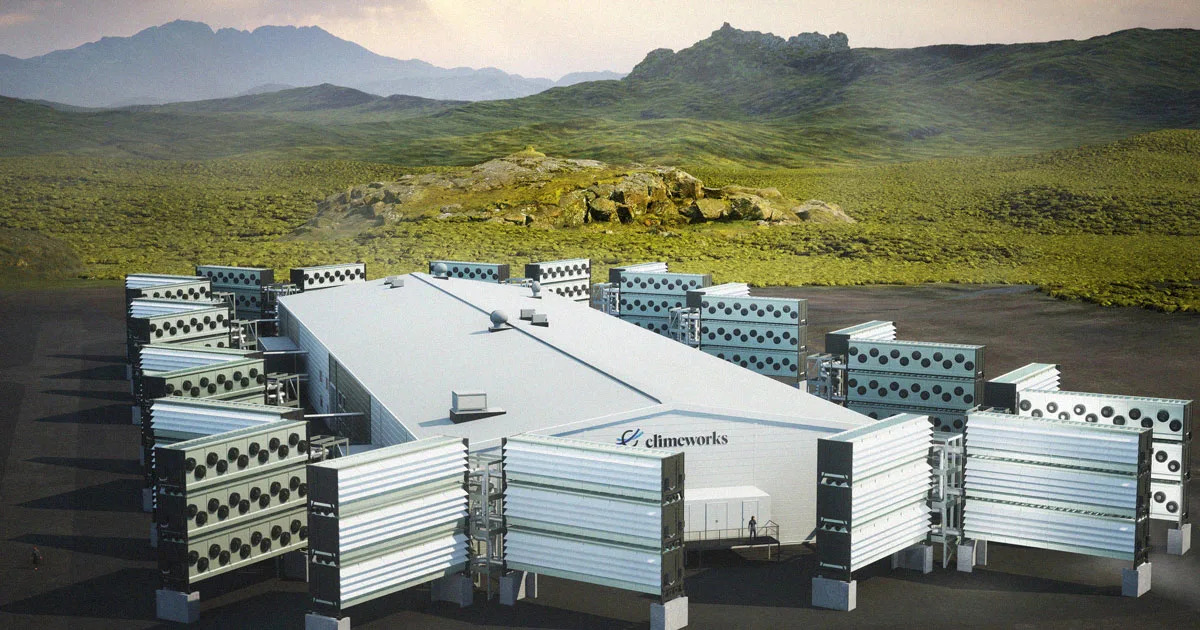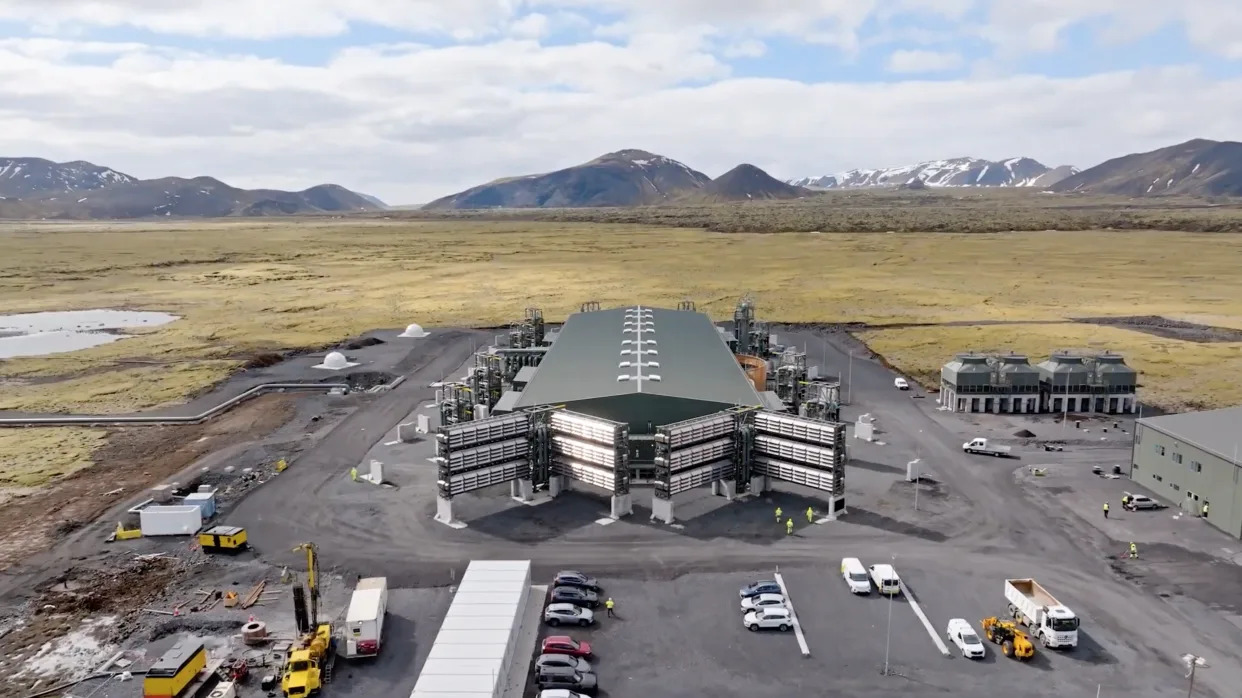Victor Tangermann
Sat, May 11, 2024

Suck It, Carbon!
A new carbon capture facility that claims to be the biggest of its kind in the world began quite literally sucking the carbon from the atmosphere this week.
The plant, called "Mammoth" by Swiss company Climeworks, kicked off operations in Iceland on Wednesday, CNN reports, grabbing the available carbon from the air and injecting it deep below the surface to lock it up permanently.
Best of all, the operation is entirely powered by the island nation's geothermal energy, allowing it to put a dent in the abundance of carbon dioxide polluting our planet's atmosphere without adding to the problem.
However, whether direct air capture (DAC) plants are our best bet to ward off an impending climate catastrophe remains a heated debate, with experts arguing they're merely a distraction from the root causes of climate change.
Making a Dent
Giant fans at Climeworks' Mammoth plant suck in the surrounding air, scrubbing it of carbon and pumping it deep into the ground where it turns into stone.
As its name suggests, the plant is absolutely enormous: ten times bigger than its three-year-old predecessor called Orca.
At full capacity, the company claims the facility can suck 36,000 tons of carbon from the atmosphere annually, the equivalent of taking 7,800 combustion-engine cars off the road per year.
But the process isn't cheap. While Climeworks didn't reveal the exact cost, each ton of carbon costs close to $1,000 to remove, CNN reports. To make the process economically feasible, that cost would have to sink closer to $100 a ton, something that Climeworks co-founder Jan Wurzbacher says would be possible by around 2050.
The idea has also caught on in the US, with startup Occidental announcing plans to build an even bigger DAC facility called STRATOS last year, which is designed to suck up 500,000 tons of CO2 per year.
Squeezing the Last Drop
However, experts remain skeptical that such facilities will be the key to fending off climate change. Many of them claim it's a dangerous distraction from far more glaring issues.
Even more worryingly, Big Oil has already adopted the concept with the hopes of extracting even more oil from the captured carbon — in the eyes of many, a step in the wrong direction.
"One of the concerns that we have is that folks are going to try and use this as an offset for continued fossil fuel production," nonprofit Carbon180 executive director Erin Burns told Axios last year, "when largely the role of carbon removal is to address legacy emissions."
"And we are seeing oil companies talk about this being a way to offset continued oil production," she added. "That's concerning."
More on carbon capture: Scientists Say New Material Can Suck Carbon Out of Atmosphere Faster Than Trees
The world’s largest direct carbon capture plant just went online
It can capture around 36,000 tons of CO2 per year, but that’s just a drop in the bucket.
Lawrence Bonk·Contributing Reporter
Fri, May 10, 2024

Climeworks
Swiss start-up Climeworks has done it again. The company just opened the world’s largest carbon capture plant in Iceland, dwarfing its own record of how much CO2 it can pull from the air. The company’s previous record-holding carbon capture plant, Orca, sucks around 4,000 tons of CO2 from the atmosphere per year, but the new plant can handle nearly ten times that, as reported by The Washington Post.
The plant’s called Mammoth and boasts 72 industrial fans that can pull 36,000 tons of CO2 from the air each year. Just like with Orca, the CO2 isn’t recycled. It’s stored underground and eventually trapped in stone, permanently (within reason) removing it from the environment. The plant’s actually located on a dormant volcano, so it’ll make a great hideout for a James Bond villain should it ever cease operations.
Fri, May 10, 2024
Climeworks
Swiss start-up Climeworks has done it again. The company just opened the world’s largest carbon capture plant in Iceland, dwarfing its own record of how much CO2 it can pull from the air. The company’s previous record-holding carbon capture plant, Orca, sucks around 4,000 tons of CO2 from the atmosphere per year, but the new plant can handle nearly ten times that, as reported by The Washington Post.
The plant’s called Mammoth and boasts 72 industrial fans that can pull 36,000 tons of CO2 from the air each year. Just like with Orca, the CO2 isn’t recycled. It’s stored underground and eventually trapped in stone, permanently (within reason) removing it from the environment. The plant’s actually located on a dormant volcano, so it’ll make a great hideout for a James Bond villain should it ever cease operations.
The location was chosen for its proximity to the Hellisheidi geothermal energy plant, which is used to power the facility's fans and heat chemical filters to extract CO2 with water vapor. After extraction, the CO2 is separated from the steam, compressed and dissolved in water. Finally, it’s pumped 2,300 feet underground into volcanic basalt. This compound reacts with the magnesium, calcium and iron in the rock to form crystals, which become solid reservoirs of CO2. It’s pretty nifty technology.
However, it’s not the end-all solution to climate change. It’s barely a blip. For the world to achieve "carbon neutrality" by 2050, "we should be removing something like six to 16 billion tons of CO2 per year from the air," said Climeworks founder Jan Wurzbacher, according to reporting by CBS News.
Therein lies the problem. This facility, the largest of its kind by a wide margin, can capture up to 36,000 tons of CO2 from the air each year, but that’s just 0.0006 percent of what’s needed to meet the minimum annual removal threshold as indicated by Wurzbacher. There are other plants, of course, but all of them combined don’t make a serious dent in what’s required to pull us from the brink.
To that end, Wurzbacher has pleaded with other companies to take up the cause. He says that Climeworks has a goal of surpassing millions of tons captured per year by 2030 and a billion by 2050. The company’s chief technology officer, Carlos Haertel, told 60 Minutes that scaling up the process globally is possible, but requires political will to rally behind the initiative.
The Biden administration recently committed $4 billion to jumpstart the industry here in the states and earmarked $1.2 billion for a pair of large-scale projects. The US Department of Energy also started a program called Carbon Negative Shot, with a goal of fostering the development of budget-friendly carbon capture technology.
The method of carbon capture deployed by Climeworks is just one of many approaches. These processes range from stacks of limestone blocks that absorb CO2 like a sponge to giant hot air balloons that freeze and trap the chemical compound. Restoring forests is another option, which is something companies like Apple and Goldman Sachs have experimented with. Which one is best? All of them together deployed at global scale. Whatever it takes. Climate change isn’t fooling around.
No comments:
Post a Comment